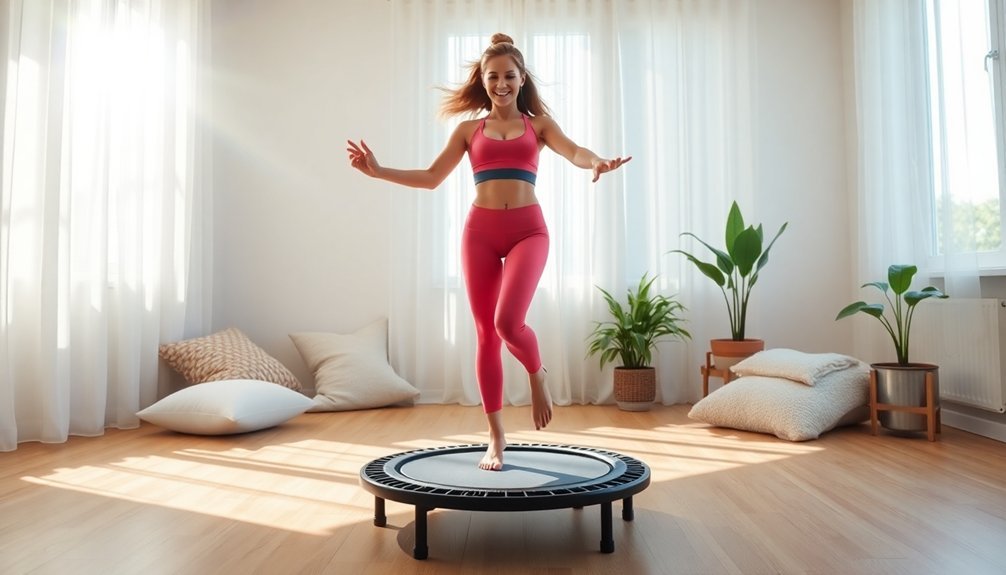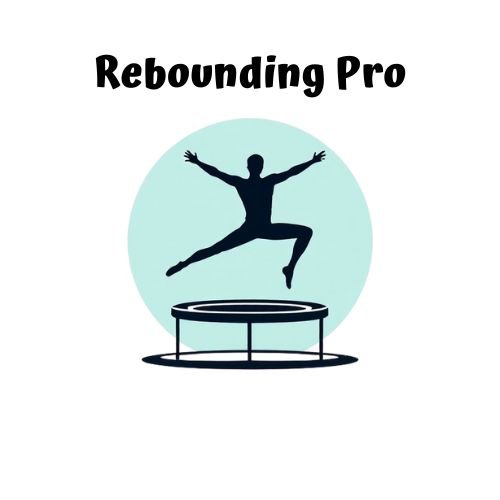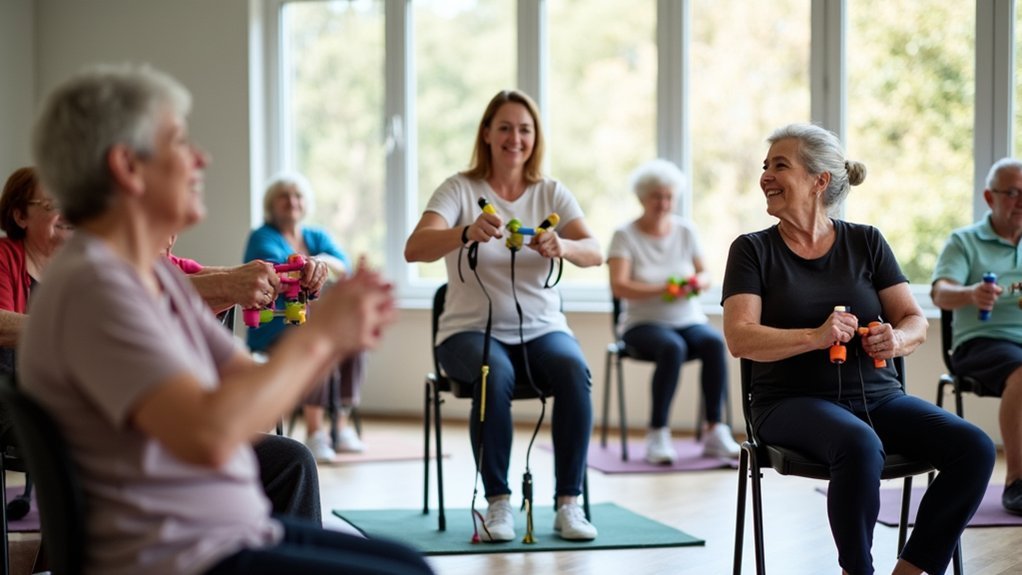You'll find three effective rebounding workouts that fit perfectly into your daily routine: a 6-minute Morning Energizer to kickstart your day, a 15-minute Midday Stress-Buster to combat afternoon fatigue, and a 10-minute Evening Lymphatic Flow for recovery. Each gentle mini-trampoline workout boosts energy, supports detoxification, and strengthens your core with minimal joint impact. These simple routines offer profound benefits for your lymphatic health and overall wellness beyond their short time commitment.
Morning Energizer: 6-Minute Gentle Rebounding Circuit

While many people struggle to find time for morning exercise, a quick 6-minute rebounding session can energize your entire day. This low-impact workout stimulates your lymphatic system, removing toxins and boosting energy levels right when you need it most.
Start your day with a lymphatic boost—just six minutes of morning rebounding delivers all-day energy when you need it most.
Create a varied routine with different moves each minute—basic bounces, leg lifts, and gentle twists—to engage all major muscle groups without repetition. Alternate between intense and gentle movements for effective interval training that maximizes cardiovascular benefits.
The gentle bouncing not only strengthens your core and improves posture but also supports bone density. This six-minute workout is specifically designed to improve movement patterns and energize you through lymph system flushing.
You'll need a mini trampoline (40-48 inches) and comfortable shoes. For added stability, consider safety bars if you're a beginner, or use mini bands to increase resistance.
Midday Stress-Buster: 15-Minute Full-Body Bounce
When midday fatigue and stress hit, a 15-minute rebounding session offers the perfect antidote. This low-impact workout combines cardio and strength training while being gentle on your joints.
Start with a basic bounce to establish rhythm, then incorporate high knees to engage your core. Add arm circles for upper body benefits and sideways twists to improve coordination. Mimic jogging motions to elevate your heart rate and maximize calorie burn. Incorporating bunny hops after squats can add intensity while maintaining the low-impact nature of the workout.
You'll notice immediate benefits as endorphins release, improving your mood and mental clarity. The rhythmic bouncing enhances both blood and lymphatic circulation, supporting detoxification and overall health.
All you need is a mini trampoline, comfortable clothing, and water. Optional handlebars provide extra stability for beginners.
Listen to your body and adjust intensity as needed.
Evening Lymphatic Flow: 10-Minute Recovery Rebound

The perfect way to end your day involves a gentle 10-minute rebounding session designed specifically for lymphatic health and recovery.
This evening routine helps increase lymphatic circulation, reducing inflammation while supporting your body's natural detoxification process.
Begin with slow, gentle bounces while incorporating arm movements to maximize fluid flow. As you bounce, practice deep breathing to enhance tissue drainage.
Alternate between gentle bounces and slightly more vigorous movements to optimize lymphatic efficiency.
Incorporate exercises like Weight Shift Jumps, which help improve balance while effectively moving lymph fluid throughout your legs.
You'll need a stable mini trampoline with a comfortable surface, and consider using a stability bar if you're new to rebounding.
Always warm up briefly and end with stretching to aid muscle recovery.
For best results, make this 10-minute session a consistent part of your evening routine to support ongoing lymphatic health.
Frequently Asked Questions
Is Rebounding Safe During Pregnancy or With Specific Health Conditions?
During pregnancy, always consult your doctor before rebounding due to balance risks. With health conditions, seek medical approval first. Rebounding's low-impact nature may work for some conditions with proper precautions and modifications.
How Does Rebounding Compare to Running for Calorie Burning?
You'll burn more calories rebounding than running—about 12.4 versus 8.5 calories per minute. It's up to 68% more efficient for cardiovascular benefits and easier on your joints while engaging more muscles.
Can I Use Rebounding as My Only Form of Exercise?
Yes, you can use rebounding as your only exercise form. It provides cardiovascular benefits, builds muscle strength, improves balance, and supports bone health. However, adding some strength training would create a more balanced fitness routine.
What's the Ideal Frequency for Rebounding Workouts per Week?
You can rebound 3-5 times weekly for ideal results, but it's flexible. Start with 10-minute sessions and listen to your body. Daily rebounding is fine if you vary intensity and allow recovery when needed.
How Do I Progress From Beginner to Advanced Rebounding Techniques?
Start with basic bounces 2-3 times weekly, then add intermediate moves like high knees and twist jumps. Once you've mastered these, incorporate advanced plyometric exercises and complex sequences to challenge yourself further.
In Summary
Rebounding doesn't need to be intense to be effective. You'll see results by consistently incorporating these gentle workouts into your daily routine. Whether you're bouncing for energy in the morning, stress relief at lunch, or lymphatic support before bed, even a few minutes makes a difference. Start where you are, listen to your body, and enjoy the unique benefits this low-impact exercise brings to your overall wellness journey.





Leave a Reply